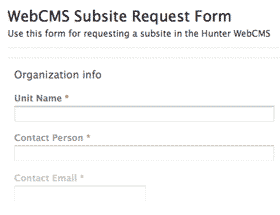What is site planning?
Site planning is the process of developing an overall outline for your website, with a strong focus on the organization of content. Think of it as "information architecture", or the process by which your content and navigation are designed.
After the initial creation of a WebCMS subsite, the staff managers and content editors are strongly encouraged to schedule a site planning meeting with the Communications Office to develop this plan. This meeting will focus on questions such as:
- Who is your target audience?
- What is your audience looking for on your site?
- What tasks do your audience hope to accomplish?
- How can your information be presented so that it's most accessible to your audience?
An Overview of Site Planning
Most websites will be composed of many pages and folders. A simple and clearly-understandable folder structure with page content that is organized into easily-digestible chunks is ideal. Sites can use pages and folder display options to manage their subsites effectively.
In cases where the needs of the audience cannot be met by a single defined page structure, added use of collections, superlinks and aliases will allow site planners to link content together for purposes of navigation and redundancy.
There are many ways to organize content, but the basic principles are:
- Create a naming system for folders and pages that will be understandable by the public (your audience). Page and folder titles should not include jargon or slang specific to your department.
- Use folders as a way for the audience to self-classify their interests. Pages within each folder should contain easy-to-read, understandable chunks of information about that topic.
- Don't over-organize at first. If a folder's contents become confusing, it's easy to create new folders and move pages around.
- While it's acceptable on occasion to make a very long page, shorter is usually better. Most pages should be as short as they need to be to get one single idea across to the reader. Focus on concise writing of pages, and allow the reader to choose their narrative path by selection of links or related items.
- Use superlinks, aliases and collections when the site's organization requires it, but consider reorganizing the site if you're relying too heavily on these tools. Having dozens of aliases and links can be confusing for both you and your audience.
Basic Steps to Develop a Site Plan
- Determine who your audience is and what information they want.
- Develop a sensible set of folders and content for the audience.
- Decide whether navigation should be contextual (navigation changes depending on where you are in the site) or parent-driven (uniform navigation for the entire site).
- Turn on/off exposure of items in the navigation menu(s) using the Navigation tab.
The Ten-Minute Site Plan
All site planners should engage in a thorough examination of their audience's needs, the types of content they manage, and the external content they may need to associate with their subsite. We suggest you come up with a chart, outline or map describing how the audience will find certain information or accomplish certain tasks, and use this as an initial guide for organizing the folders in your subsite. Keep content simple and clear organization should follow from some basic principles:
- Name folders based on your audience's interests, tasks or objectives. Put pages into these folders to expand on each topic.
- Change the order of pages within each folder as needed. For folders that should feature one specific item, use the display options menu to set one item as the "default view".
- Refine your navigation using the Navigation tab within each folder. Check or un-check the appropriate boxes to make the navigation work for your audience.
- If some topics become too large for a single page, make a new folder. Check the names of your folders to ensure that the breadcrumb trail always makes sense. It should go from big topic > sub-topic > specialized topic in such a way that users will have some idea of where they are and where they're going.
- Let the portlets handle the display of news, events, seminars and announcements. Clicking on "More..." in each portlet will display a list of news or events for your site. Recruit people in your department or office to write up news and event information, and assign them the roles necessary to add this content to the website. The more content they add, the more the site planner has to work with.
- Change the default Welcome page into one that features something you want your visitors to see right away. Don't be afraid to change it; the WebCMS makes it easy to update.
- Use a static text portlet to feature important content or information. Use an RSS portlet to subscribe to a feed that may be of interest to your audience. Use a collection to automatically display content related to a single topic, even if the content isn't all in the same folder. Use superlinks and aliases to link to or pull in content from other locations.






